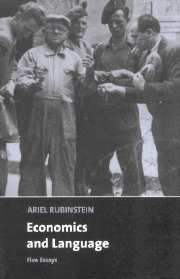1 - Choosing the semantic properties of language
Published online by Cambridge University Press: 22 September 2009
Summary
Introduction
This chapter will present a research agenda whose prime objective is to explain how features of natural language are consistent with the optimization of certain “reasonable” target functions. Rather than discuss the research agenda in abstract, I will begin with the specific argument and return to the general discussion at the end of the chapter.
This chapter discusses binary relations. A binary relation on a set Ω specifies a connection between elements within the set. Such binary relations are common in natural language. For example, “person x knows person y,” “tree x is to the right of tree y,” “picture x is similar to picture y,” “chair x and chair y are the same color,” and so on. I will avoid binary relations such as “Professor x works for university y” or “the Social Security number of x is y,” which specify “relationships” between elements which naturally belong to two distinct sets. I will further restrict the term “binary relation” to be irreflexive: No element relates to itself. The reason for this is that the term “x relates to y” when x = y is fundamentally different from “x relates to y” when x ≠ y. For example, the statement “a loves b” is different from the statement “a loves himself.”
Certain binary relations, by their nature, must satisfy certain properties.
- Type
- Chapter
- Information
- Economics and LanguageFive Essays, pp. 9 - 24Publisher: Cambridge University PressPrint publication year: 2000

